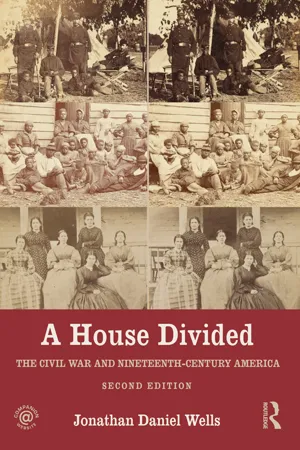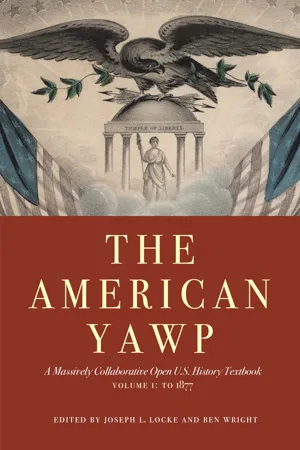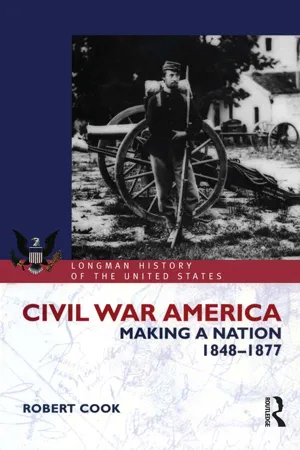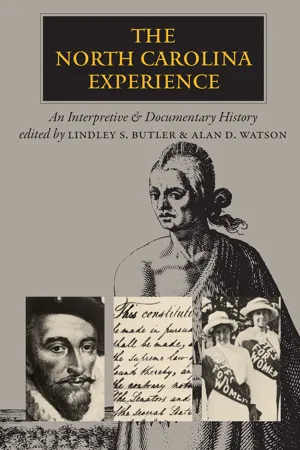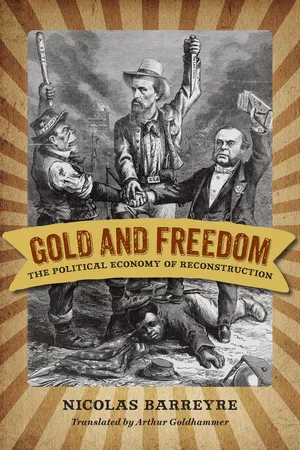History
Reconstruction in the South
Reconstruction in the South refers to the period following the American Civil War, during which the federal government sought to rebuild the Southern states and integrate formerly enslaved individuals into society. This era was marked by efforts to establish new political and social structures, including the passage of civil rights amendments and the establishment of Freedmen's Bureau to provide assistance to newly freed slaves.
Written by Perlego with AI-assistance
Related key terms
8 Key excerpts on "Reconstruction in the South"
- eBook - ePub
A House Divided
The Civil War and Nineteenth-Century America
- Jonathan Daniel Wells(Author)
- 2016(Publication Date)
- Routledge(Publisher)
The end of the Civil War also settled the issue of secession. No longer could southerners claim with any credibility the right to withdraw from the Union, though reactionary southerners would continue to make such claims well into the twentieth century. At the end of the war, all the former Confederate states had to rescind their secession ordinances to be readmitted into the Union. Still, the debate over state power versus federal authority did not calm down after the war; in fact, the corridors of power in Washington struggled not only with how much authority the federal government should exercise in protecting the civil rights of former slaves, but Washington itself was deeply divided between the president and Congress. Although the Fourteenth Amendment provided a definition of citizenship that embraced African Americans, the controversy over state and federal government powers persisted into the late nineteenth century and continued to occupy the nation throughout the twentieth century.So Reconstruction was a crucial period in the nation‘s history because of the new questions that arose after the war. Slavery and secession were dead forever. But the shape the newly reestablished Union would take was far from settled by 1877. Americans fought over competing and even contradictory visions of the nation‘s future.At the outset of Reconstruction, though, few knew what to expect. The nation had ventured deep into unchartered territory. Since the Founding Fathers had not anticipated secession, there was no clear plan for rebuilding the Union. How exactly does a country so horrifically divided for four long and deadly years reconstitute itself? Should Congress or the president play the leading role in formulating policy? Would former Confederates be permitted to rejoin the United States? If so, what limitations if any should be placed on their rights? Should they be punished for rebelling against the Union? What should be done to help the former slaves find work and shelter? Who would protect them against vengeful whites? Throughout the years after the war the nation wrestled with these weighty questions. - eBook - ePub
The American Yawp
A Massively Collaborative Open U.S. History Textbook, Vol. 1: To 1877
- Joseph L. Locke, Ben Wright(Authors)
- 2019(Publication Date)
- Stanford University Press(Publisher)
15 ReconstructionI. IntroductionContrabands , Cumberland Landing, Virginia, 1862. Library of Congress.After the Civil War, much of the South lay in ruins. “It passes my comprehension to tell what became of our railroads,” one South Carolinian told a northern reporter. “We had passably good roads, on which we could reach almost any part of the State, and the next week they were all gone—not simply broken up, but gone. Some of the material was burned, I know, but miles and miles of iron have actually disappeared, gone out of existence.”1 He might as well have been talking about the entire antebellum way of life. The future of the South was uncertain. How would these states be brought back into the Union? Would they be conquered territories or equal states? How would they rebuild their governments, economies, and social systems? What rights did freedom confer on formerly enslaved people?The answers to many of Reconstruction’s questions hinged on the concepts of citizenship and equality. The era witnessed perhaps the most open and widespread discussions of citizenship since the nation’s founding. It was a moment of revolutionary possibility and violent backlash. African Americans and Radical Republicans pushed the nation to finally realize the Declaration of Independence’s promises that “all men are created equal” and have “certain unalienable rights.” White Democrats granted African Americans legal freedom but little more. When black Americans and their radical allies succeeded in securing citizenship for freedpeople, a new fight commenced to determine the legal, political, and social implications of American citizenship. Resistance continued, and Reconstruction eventually collapsed. In the South, limits on human freedom endured and would stand for nearly a century more.II. Politics of ReconstructionReconstruction—the effort to restore southern states to the Union and to redefine African Americans’ place in American society—began before the Civil War ended. President Abraham Lincoln began planning for the reunification of the United States in the fall of 1863.2 With a sense that Union victory was imminent and that he could turn the tide of the war by stoking Unionist support in the Confederate states, Lincoln issued a proclamation allowing southerners to take an oath of allegiance. When just 10 percent of a state’s voting population had taken such an oath, loyal Unionists could then establish governments.3 - eBook - ePub
Civil War America
Making a Nation, 1848-1877
- Robert Cook(Author)
- 2014(Publication Date)
- Routledge(Publisher)
7WAR BY ANY OTHER NAME: THE STRUGGLE OVER RECONSTRUCTION, 1865–76
The welcome return of peace in the spring of 1865 witnessed a continuation of the wartime Reconstruction process that would resolve as yet unanswered questions about the relationships pertaining between state and federal governments, North and South, and blacks and whites. More specifically, it brought into sharper focus a problem that had bedeviled all postemancipation societies in the western hemisphere: how to effect a smooth transition between slavery and freedom. Because this problem was intertwined with the task of promoting national reconciliation and the strugglè to order power relations in the newly restored Union, the fraught politics of Reconstruction dominated American life in the decade after the Civil War.Lincoln’s successor in the White House, Andrew Johnson, undertook to restore the late Rebel states to their proper constitutional place inside the Union. His mistake was to underestimate the impact that the Civil War had had on the people of both sections. When it seemed apparent that Johnson’s lenient policies were allowing ex-Confederates to obstruct federal policy and regain their former influence through the ballot box, congressional Republicans attempted to promote at least a modicum of reform in the conquered South. Black suffrage made possible the sudden entry of black Americans into southern political life, a development that was contested fiercely by their former masters. Only as war memories began to fade and new issues began to preoccupy the country did Reconstruction come to an end.The aftermath of war
In his brief second inaugural address delivered on March 4, 1865 President Abraham Lincoln, chastened by God’s evident determination to punish Americans for the sin of slavery, announced that having fought a hard war, he would seek a generous peace. As his rousing peroration made clear, his overriding goal was national reconciliation: - eBook - ePub
- David Prior(Author)
- 2018(Publication Date)
- Fordham University Press(Publisher)
34The transition may have been much quicker and more striking with reconstruction as resurrection. During the secession crisis, even a radical paper like The Liberator took the term to refer to a potential reunification of North and South, as did the ideologically diverse sources The Liberator reprinted and excerpted.35 Abraham Lincoln, Andrew Johnson, and the Report of the Joint Committee on Reconstruction all used Reconstruction to refer to the process whereby federal authority would return to the South, the southern states would return to the Union, and the country would be reunited. Often, Lincoln, Johnson, and the Report used Reconstruction interchangeably with “restore” and “restoration,” which sometimes also referred to the extension of rights to former Confederates.36 At least one source declared Reconstruction complete when Georgia returned to full statehood in 1870.37By 1867, if not before, political partisans started linking Republican legislation with older ideas about the reconstruction of society, the latter already having longstanding and mostly negative connotations. At least four papers reprinted from the New York Herald an editorial that condemned the Republican Party for reconstruction laws that would bring “social ruin” to the South to “secure power to a coterie of politicians.” The Herald commented that, if the Democratic Party’s track record was poor, at least it could boast that if it “had ever desired to reconstruct society it was in the interests of the white man.”38 Writing in the shadow of Republican legislation, the Charleston Daily News - eBook - ePub
The North Carolina Experience
An Interpretive and Documentary History
- Lindley S. Butler, Alan D. Watson(Authors)
- 2010(Publication Date)
- The University of North Carolina Press(Publisher)
Chapter 13Reconstruction
The Halfway Revolution Allen W. TreleaseGenerals Steedman and Fullerton Conferring with Freedmen at the Trent River Settlement, Harper’s Weekly, 9 June 1866 (Courtesy of the Division of Archives and History, Raleigh, N.C.)No period in American history has undergone a greater change in historical interpretation than the Reconstruction era. This change resulted from the civil rights movement (or Second Reconstruction) of the 1950s and 1960s. Older treatments of Reconstruction rested on whitesupremacist assumptions that could no longer be accepted. Historians took a new and more appreciative look at Thaddeus Stevens, Charles Sumner, and the other Radical Republicans of the 1860s, who strove to guarantee a genuine freedom and equality for black people. Occasionally the historiographical reaction may have gone too far, idealizing men who (like their opponents) were often motivated by partisan and personal considerations as well as humanitarian ones. But the new view has endured, with successive refinements of detail and interpretation.The Republican party not only led the Union to victory in the Civil War but also assumed almost exclusive responsibility for the abolition of slavery in the face of indecisiveness or outright opposition by northern Democrats. In 1865, therefore, Republicans had some reason to see their party as the indispensable safeguard of the Union and the blacks, and a political defeat would imperil the military victory just won at the cost of four years of death and sacrifice. A quick restoration of the South, with no conditions attached beyond an oath of future loyalty, threatened to let former Confederates resume the position they had held in 1861 when they broke their former oaths of loyalty. Who, then, would protect the black population against new forms of servility and exploitation, no longer called slavery but closely resembling it? Who would keep the men in gray from returning to Washington and taking over the federal government in alliance with northern Democrats, who had previously supported them to the verge of secession? Unless preventive measures were taken, the former rebels would actually gain power in Congress and the electoral college as a result of the Republican policy of emancipation. (Southern states had been able to count three-fifths of their slaves for purposes of representation; now five-fifths of the blacks would be counted, yet virtually no southerner proposed giving them any vote or voice in government.) Republicans were determined not to see the Civil War end that way. They differed, however, in how far they would go to prevent it. - eBook - ePub
Gold and Freedom
The Political Economy of Reconstruction
- Nicolas Barreyre, Arthur Goldhammer(Authors)
- 2015(Publication Date)
- University of Virginia Press(Publisher)
PART IIReconstructionPassage contains an image
4Closing the Books on the WarREPUBLICANISM, CIVIL RIGHTS, FINANCEThe Union of these States, one & inseparable—upon the basis of equal rights to every loyal man North and South—is the item of great moment now. . . . After this is accomplished, there is one thing which seems to me, more than another to demand the earnest attention of Congress, to wit—the National finances—& the laws governing distribution.— George Locey to Andrew Johnson, February 25, 1866WHEN CONFEDERATE FORCES surrendered in April 1865, there was no hint that the money question would become so contentious or that the Midwest and Northeast would clash so directly over the economy. After four years of bloody war, Americans had one concern: to ensure a lasting peace. But the task was arduous, the problems thorny. What did the Union victory really mean? What consequences should the Confederate states suffer for having seceded? What reforms were needed to make sure no such thing would ever happen again? And above all, what should be the place of the 4 million blacks made free by the abolition of slavery?The great issue of the day was thus: what kind of society did Americans want to build in the wake of the Civil War? And this hinged on a newly important concept—national citizenship. Defining national citizenship, deciding who would participate in it, and assigning it concrete legal and political content would prove to be among the major legacies of the postwar debates. Surreptitiously, almost illegitimately, economic issues influenced these debates. What connection was there between civil rights and paper money? What role did the tariff play in the reform of the South? At first glance, the answer is none. And yet, the convertibility of greenbacks into gold, the system of taxation, and protectionism would turn out to have an immense impact on the course of Reconstruction.1 - eBook - ePub
Eighty-Eight Years
The Long Death of Slavery in the United States, 1777–1865
- Patrick Rael, Richard Newman, Manisha Sinha(Authors)
- 2015(Publication Date)
- University of Georgia Press(Publisher)
Toward the end of Reconstruction, Frederick Douglass asked, “If war among the whites brought peace and liberty to the blacks, what will peace among the whites bring?” 18 Here was his answer. In 1877, a Georgia writer offered British imperialists in South Africa some advice on coping with their labor problem. “The only way to treat the negroes in South Africa is to enslave them,” he wrote. “Nothing but slavery will ever raise the savage negro to a condition approximating to civilization, and nothing but slavery, as our own unhappy experience since the war had demonstrated, will ever make him industrious.” 19 The writer’s confidence in suggesting that the British reimpose slavery on their colonies was nothing short of astounding, coming as it did a mere twelve years after southern slaveholders had lost their secession wager in a war that utterly destroyed their institution and at a cost of three-quarters of a million souls. Such, though, was the hubris bred by Redemption. The failure of Reconstruction even impacted the memory of the long process through which the nation threw off chattel bondage. In the history of slavery’s demise in the Atlantic world, the thoroughness with which the Civil War’s causes were expunged from the historical record is remarkable. With Redemption, the Confederate view of history became the standard interpretation for much of the next century. Abolitionism became a small movement of fanatics, secession the product of legitimate squabbles over states’ rights. The war itself became a noble tragedy, and Reconstruction the triumph of civilization over the forces of barbarism and tyranny. It is sometimes said that the winners write history. Perhaps, but it is difficult to think of another modern instance in which the losers came to exercise such enormous control over a national story - eBook - ePub
Liberty and Union
A Constitutional History of the United States, concise edition
- Edgar J. McManus, Tara Helfman(Authors)
- 2014(Publication Date)
- Routledge(Publisher)
Civil government would be restored to the South only when the conditions set by Congress had been met. First, the military would enroll the loyal voters for the election of state constitutional conventions. There would be universal male suffrage, with blacks included, but large numbers of ex-Confederates barred from voting. The constitutions drafted would have to guarantee freedmen the right to vote and hold public office. After the constitution had been ratified by the voters and approved by Congress, elections would be held and civil government restored. The final hurdle would be ratification of the Fourteenth Amendment by the newly elected state legislature. The state would then be eligible for representation in Congress as soon as the amendment became part of the Constitution. Until then, all political arrangements in the South would be temporary and provisional. The Radicals had no intention of readmitting the southern states until ratification of the Fourteenth Amendment had put the civil rights of the freedmen under federal protection.The enfranchisement of blacks and disfranchisement of numerous whites were essential parts of political reorganization. At least 200,000 southern whites were barred from voting or holding public office for having supported the Confederacy. Their exclusion gave blacks an overall voting majority that made the South temporarily Republican. One-third of the delegates elected to the state conventions were African Americans, and in South Carolina they were in the majority. Many northerners, derisively called “carpet-baggers,” provided leadership in the work of political reorganization. They helped to draft the new state constitutions, which were usually based on northern models, and many of them were elected to high office in the new state governments. Large numbers of southern whites, the much scorned “scalawags,” also played leading roles in organizing the new regimes. While blacks provided the votes needed for political reorganization, white carpetbaggers and scalawags controlled most of the public offices. But not all the offices went to whites. For the first time in the history of the South, African Americans filled positions in state and local government as mayors, sheriffs, and lawmakers, and some went on to serve as senators and representatives in the U.S. Congress.The political dividends of Radical Reconstruction were not slow in coming. Grateful to the Republicans for emancipation and federal protection, southern blacks joined the party in droves. The work of organizing them as a political force was carried out by the Freed-men’s Bureau and the Union and Loyal Leagues that sprang up in the South. The latter were local political action groups that put up candidates and got out the vote. The bureau, which was officially nonpolitical, provided a conduit for federal patronage and money. The Freedman’s Bureau and the Loyal Leagues worked in tandem to build a Republican Party infrastructure in the South. But the political arrangements counted for less than the military support needed to keep the southern Radicals in power. Their governments were propped up by 20,000 federal troops and contingents of black militia. The troops were needed to protect black voters from disfranchised whites who increasingly resorted to terror and violence. Without them, the political structures would have collapsed like a house of cards.
Learn about this page
Index pages curate the most relevant extracts from our library of academic textbooks. They’ve been created using an in-house natural language model (NLM), each adding context and meaning to key research topics.
